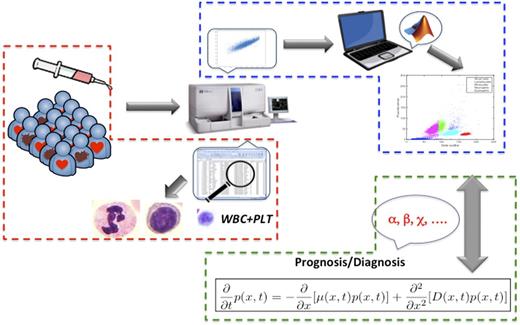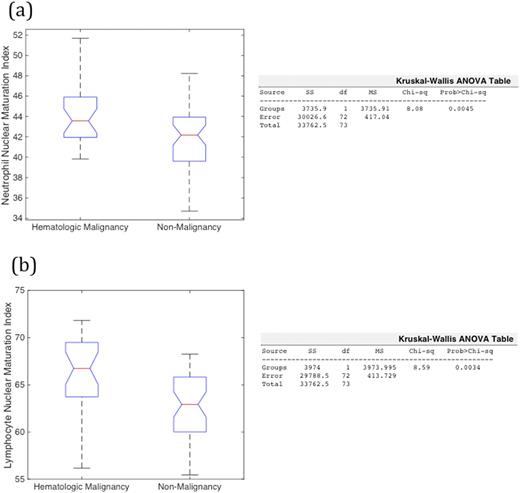Abstract
The complete blood count (CBC) is one of the most commonly ordered clinical tests because it provides a snapshot of the current state of the hematologic system in a patient, including an estimate of the number of currently circulating white blood cells (WBC). This simple assessment of patient WBC count is valuable in the screening and monitoring of a very wide range of conditions, from infection to malignancy to autoimmunity. Many routine WBC counts are measured by sophisticated automated hematology analyzers that rely on the principles of flow cytometry and characterize the morphology of thousands of individual WBCs in the process of providing a simple WBC count. These single-WBC measurements collected at high-throughput are usually discarded, but the probability distributions they represent provide a glimpse into the dynamics of the circulating WBC population, potentially enabling clinicians not only to estimate current numbers of circulating WBCs but also to infer whether the numbers of WBC subtypes (neutrophils, lymphocytes, and monocytes) are likely to increase or to decrease in the subsequent days and weeks.
We utilize this otherwise discarded single-WBC information in combination with semi-mechanistic mathematical models of neutrophil, lymphocyte, and monocyte population dynamics to infer patient-specific rates of neutrophil, lymphocyte, and monocyte flux (Figure 1). We characterize differences in average flux for patients with different classes of disease (infection, hematologic malignancy, and cardiac ischemia) and show how the data collected in a simple CBC and differential may be helpful in the early diagnosis and prognosis for a number of important diseases. For instance, we assess the diagnostic efficiency of inferred WBC dynamics to help identify (1) patients with initially negative cardiac troponins who are most likely to have subsequent positive levels, and (2) patients with newly discovered leukocytosis who are more likely to have an underlying malignant hematologic process. In a retrospective study of 73 patients with mild to moderate leukocytosis (11 x103/uL < WBC < 20 x103/uL) of unknown etiology, this approach showed promise in helping to identify patients who were diagnosed with a hematologic malignancy in the subsequent 6 months (Figure 2).
Figure 2: Nuclear maturation distributions of neutrophils (a) and lymphocytes (b) were derived from raw CBC measurements for patients found to have moderately elevated WBC counts (> 11x103/uL and < 20 x103/uL) before an underlying disease process had been identified. A statistically-significant fraction of patients with a subsequent new diagnosis of a hematologic malignancy could be identified based on either their single-neutrophil or single-lymphocyte characteristics at the time of the CBC up to 6 months prior to diagnosis, with multivariate discriminants showing even better performance.
No relevant conflicts of interest to declare.
Author notes
Asterisk with author names denotes non-ASH members.




This feature is available to Subscribers Only
Sign In or Create an Account Close Modal